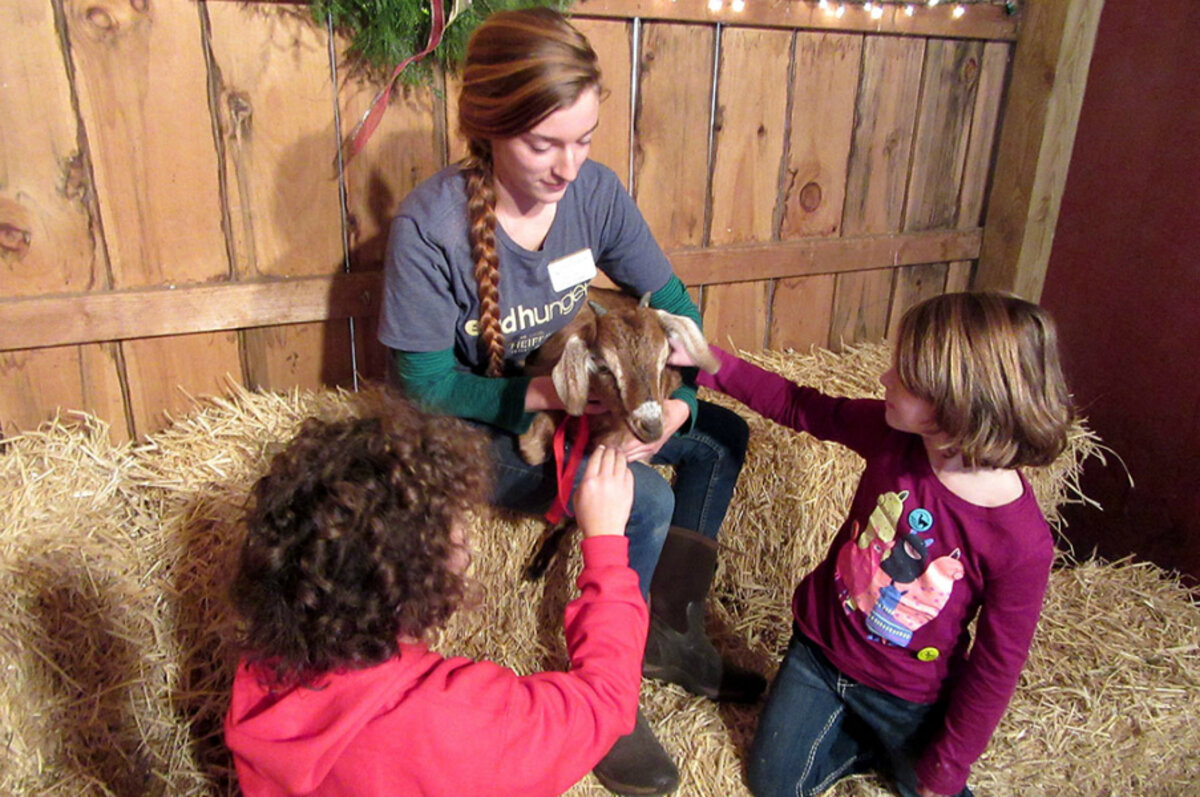Heifer Farm teaches sustainable ways to end hunger
Loading...
| Rutland, Mass.
On some quiet, rural acres in central Massachusetts visitors from around the eastern United States are learning how agriculture can change the world.
The Heifer Farm model for transforming lives doesn’t involve vast, undulating seas of corn, or “factories” where formerly free-range animals live in a confined environment in order to more quickly become meat.
Instead, Heifer’s is a gentle, small-scale approach – one that’s been used to improve living standards in scores of countries for 70 years.
“We hope to create awareness of hunger- and poverty-related issues as well as sustainable solutions to those problems,” says Shon Rainford, senior director of Heifer Farm and Ranch.
Motivated by this awareness, visitors will return home wanting to support the worldwide nonprofit mission of Heifer International, Mr. Rainford hopes. And their own lives will be transformed as well.
To that end, Heifer Farm, in the small town of Rutland, offers a profusion of programs, ranging from four-hour visits to learn about animals and agriculture to five-night stays at the farm’s Global Village, which offers a taste of life in countries such as Guatemala, Kenya, and Poland – several of the places where Heifer is working to end hunger and poverty.
Most participants are from school and church groups, and are children, teens, and college students.
As many as 24 adult volunteers live and work at Heifer Farm for periods of up to a year. They dig deeply into sustainable farming practices and learn how Heifer International is working to advance communities in 40 different countries – not by dropping off sacks of food, but by providing the means and training for these communities to grow their own food, and work their way out of poverty.
Heifer Farm’s sister site, Heifer Ranch in Arkansas, which Rainford also manages, is near Heifer International’s headquarters in Little Rock, Ark., and offers similar programs.
Behind Heifer Farm’s modest but welcoming visitor center, with its classrooms, dining area, and administrative offices, is the 3/4-acre plot where most of the food is grown – more than 50 different varieties of vegetables, herbs, and fruits. Nearby is a traditional red barn; a large open-air roofed enclosure for goats, sheep, and other animals; and a field for cattle. A hiking trail through the woods begins at the Global Village.
The 14,000 pounds of organic food the farm harvests each year primarily feeds the program participants.
“We could do things differently [and farm more acres], Rainford says. But “our motivation is to educate the public and ... not to compete against local farmers.”
Some of the young visitors, Rainford says, "have no idea that a tomato comes off a plant.” But by the time they leave they may have harvested vegetables from the garden, milked a goat, and learned that locally grown organic food tastes much better than produce from a conventional farm that may be hundreds or even thousands of miles away.
Visitors also learn about sustainable, organic farming methods. To keep soil fertile, Heifer staff and volunteers – who mostly employ “people power” – take a number of extra steps, including crop rotation, mulching, and composting.
Many people know Heifer International through its unique gift catalogs. Instead of offering robotic vacuum cleaners, or T-shirts with snarky messages, these catalogs feature goats, pigs, and cows – and equipment, such as biogas stoves and irrigation pumps.
The gifts, of course, go to places far away from a shopper’s family and friends; instead they receive “honor cards.” But before these gifts are presented, Heifer staff will train families how best to humanely care for animals, and spend several years working with communities to use gifts to build a better life for themselves.
Heifer International’s women’s empowerment program works in tandem with its farming project.
“If we’re going to eliminate hunger and poverty we need to elevate the status of women all over the world,” Rainford says. Heifer Farm’s three-night Women’s Lambing program each spring features discussions related to women’s empowerment, along with learning and hands-on work with animals.
Liz Ellis, a community engagement officer for Heifer, says, “Working with kids, we see light bulbs go on in the Global Village.” For children who live for several days in, say, the Tibetan plateau house from China, or the Peru house, the experience may be “a little outside their comfort zone [even as they realize other] people live like this on a daily basis.”
Ms. Ellis says that “The meals [in the Global Village] are very simple.” With supervision, participants fix their own dinner.
“Everyone is well fed, but there’s not limitless food” – no bags of Cheetos for before-bed snack time. “So some children may even be a little hungry for the night.” But of course this, too, helps participants connect with the experience of people around the world where Heifer is working to change lives.
• Heifer Farm is open to visitors every day of the year from 9 a.m. to 5 p.m. Learn more at .




